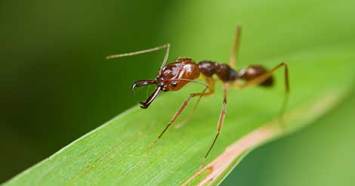
Fire ants (Solenopsis invicta), also known as red ants, are a common nuisance in the environment in certain areas, especially within the Southeastern United States. They originated in South America but have migrated to the US through various means, including commerce and travel. Fire ants build nests or colonies that look like large dirt mounds (i.e., ant hills). They are often attracted to moist areas and tend to prefer to build their nests around structures, such as sidewalk edges and cracks, against housing, or at the base of trees and bushes. They will travel pretty far from the nest for food and water if needed, so an ant hill near your house could result in a home infestation in some cases.
Do fire ants bite or sting?
Fire ants don’t actually bite. Fire ants are part of a group of stinging insects within the order Hymenoptera, which includes bees and wasps. Fire ants sting by grabbing and holding with their jaws and injecting venom (envenomation) with a stinger on their abdomen (the rear part of their body). They do not die after stinging.
Symptoms of Fire Ant Stings on Dogs
Within 15 minutes after a fire ant sting, swelling, redness, and thickening of the skin may occur. Several hours later, the sting site may look like a bright red, raised area, one to two centimeters wide. These areas can be extremely itchy. Sometimes pustules may occur (as they do in humans), which look like raised areas of skin full of white or yellow fluid. The sting area can also look like a flat one to two centimeter-wide red circle on the skin.
Are fire ant stings dangerous to dogs?
They can be. If a dog is bit by many ants at one time, the amount of venom injected can lead to severe reactions. In rare cases, some dogs can also develop an anaphylactic reaction from just one sting. Symptoms of a reaction include trouble breathing, laying on their side and not responding to an owner’s voice or touch, seizures, and pale skin or bruising. Reactions can be an emergency situation and veterinary care should be sought as soon as possible.
Safely Removing Fire Ants from Dogs
If you see fire ants on your dog, brush them off quickly. You may want to use a cloth or gloves to avoid getting the fire ants on you. Rinsing your pet off with a hose can be helpful. Unfortunately, removing ants while they are stinging can be difficult because their jaws are strong and used to hold themselves in place to inject venom. Trying to remove ants can also agitate them more and lead to more stings, so be as quick as you can.
Treating Fire Ant Stings
Just a few stings on a pet are not typically a cause for concern if they are acting normally. Within 24-72 hours, the sting sites should improve. If your pet is itchy or uncomfortable, Benadryl or diphenhydramine can be used. Your veterinarian will be able to provide you with the proper dose based on your pets age and body weight. Cool water baths can help with some of the inflammation in their skin. Avoid using over-the-counter creams or lotions unless your veterinarian says they are safe.
If your pet is extremely itchy or uncomfortable, the veterinarian may give them a steroid injection or dispense steroid tablets. Antibiotics are usually not necessary unless your pet develops an infection from scratching the stings. If your pet is showing symptoms beyond itchiness, this could be a sign of a reaction. Your veterinarian may need to take other measures such as epinephrine injections or hospitalization to ensure your pet recovers well.
Preventing Fire Ants
Treat your yard if you see fire ant mounds. Many products are available, just be sure to read the labels so that they are safe to use around your dog. If ants are a problem in your home, treating your home may be necessary too. Do not use outdoor baits inside the home because they attract ants. Clean any food or drink spills. Keep food, including dog food, in tightly sealed containers.
No preventative products exist to protect dogs from fire ants. Remember that they can be attracted to moisture so avoid wet areas when walking your dog. Do not let your dog nose around or sniff ant hills. If you live in an area with a lot of fire ant colonies, consider getting booties for your dog to wear during walks.